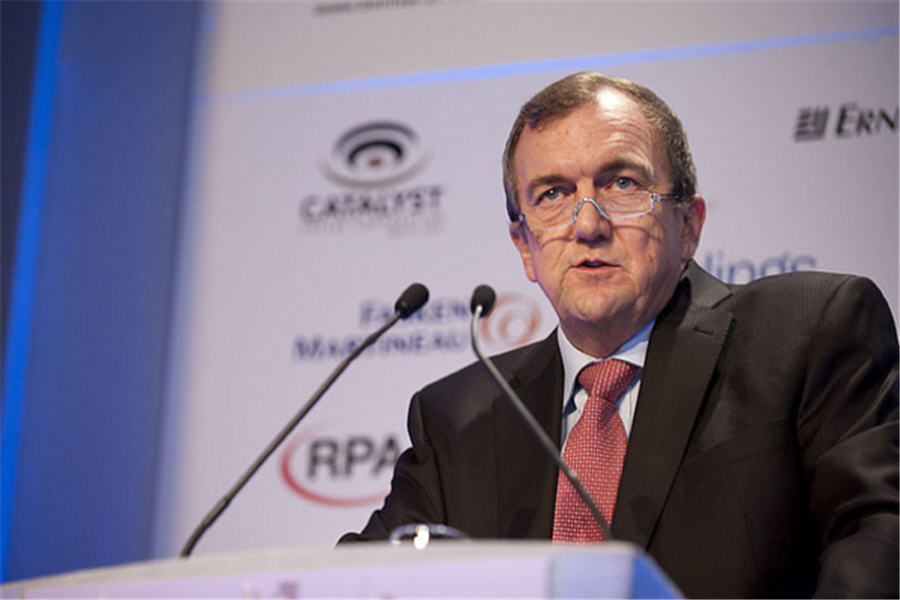Barrick Gold’s new CEO dismisses Canada HQ debate as `hysteria’

Barrick Gold Corp.’s new chief executive is surprised by the “hysteria” over whether the world’s largest gold miner will remain a Canadian company.
Barely a week after his Channel Islands-based Randgold Resources Ltd. merged with Barrick, Mark Bristow says he’s determined to keep the global miner headquartered in Toronto — or at least as committed as he is to any head office.
“Mining industries have to catch up with the reality of the times,” Bristow said
“Mining industries have to catch up with the reality of the times,” Bristow said in a phone interview from Jackson Hole, Wyoming, where he maintains a home. “We can’t sit in this massive corporate office — this old tradition — trying to run an organization that’s global by remote control.”
Bristow’s comments come in the wake of critical commentary by industry veteran Pierre Lassonde, who said Barrick’s reduced presence in Canada amounts to the kind of hollowing out of the country’s mining sector that Barrick’s late founder, Peter Munk, vigorously opposed. Lassonde was particularly critical of the fact that Barrick’s top company leaders — Bristow, Chief Financial Officer Graham Shuttleworth and Executive Chairman John Thornton — aren’t based in Canada.
‘One Room’
“The head office of a company is where the CEO and the CFO sit, and they have to sit in one room,” Lassonde, chairman of Toronto-based Franco-Nevada Corp., said Tuesday on BNN Bloomberg. “This is not going to be a de facto Canadian company, period.”
Bristow, who has often said he modeled Randgold on Munk’s vision for the company, doesn’t understand Lassonde’s comments. Munk was a great entrepreneur who “always aspired to build a world-class business,” Bristow said, and that focus will continue.
That means embracing digital innovation at mine sites and getting real-time information to mine managers and executives faster, said Bristow, who built the former Africa-focused, London-listed Randgold into one of the U.K.’s great corporate success stories.
His comments align with a push, under Thornton, to decentralize operations at Barrick, where the Toronto headcount has been cut from a year ago when the miner’s head office occupied two floors of a downtown skyscraper. With another round of layoffs late last year, the current headcount is now 60 to 70 employees on just one floor, Bristow said. He declined to give a target for future staffing, saying “I don’t paint by numbers.”
Constant Motion
Barrick’s head of strategy, Kevin Thomson, will be based in Toronto as will its other departments such as treasury, human resources and finance, Bristow said. Other executives, especially Bristow, will be in constant motion. By February, he will have visited all of Barrick’s assets in South America and Africa, as well as Canada’s Hemlo mine.
Meanwhile, Toronto staff will be expected to travel to deal with problems rather than hauling mine-site employees back to head office, Bristow said. “There’s no good us holding engineers in Toronto that are not prepared to go to Nevada to look after the interests of the shareholders.”
Under the merger, Barrick incorporated in the province of British Columbia, in part to take advantage of rules that allow it to reduce the number of Canadians on its board. Bristow says he expects the corporate office to remain in Toronto where the stock is listed.
‘SWAT Team’
Canada serves two purposes for Barrick: a desirable jurisdiction for its corporate office and a potential source of new production through increased exploration. Barrick only owns one working mine in the country, Hemlo near Thunder Bay, and hasn’t decided whether to keep it.
“As we speak we’ve got a whole SWAT team in Hemlo,” Bristow said. The asset has strategic value, but if it can’t be returned to long-term profitability it will be sold.
Ideally Barrick would like more profitable assets in Canada. But right now executives aren’t aware of any projects that clear the company’s “Tier 1” hurdle rate, which requires, among other things, that an acquisition generate an internal rate of return of at least 15 percent and have more than 5 million ounces of mine-able gold. That said, the company could consider “Tier 2” acquisitions, in Canada and elsewhere, which could be smaller projects with a higher IRR.
‘Proud Canadian’
Bristow foresees no trouble maintaining Barrick’s relationship with China or Saudi Arabia despite a tense relationship between those countries and Canada. Barrick has copper assets in Saudi Arabia and has actively pursued partnerships with Chinese companies.
While Bristow wants to be a “proud Canadian” company, “at the end of the day, business is business,” he said. If it becomes necessary to comment on geopolitics, Barrick’s board may wade in. For now, though, there’s nothing that makes him anxious. “We will continue to work with our partners wherever they are.”
Going forward, Barrick intends to reinvest for the long-term and is “100 percent” positive it can do so while still generating positive free cash flow for investors.
“We want to get the debt down, the dividends up, and to do that you’ve got to have a long-term sustainable ability to invest in your own future,” he said, noting there is a cautionary tale for Canada in that approach.
“To continue to be relevant and to be a global leader, you’ve got to invest in your future, and that also goes for whole countries,” Bristow said. “Canada is a country which, without a doubt, is the headquarters for mining globally, but it also needs to work on it.”
(By Danielle Bochove)
More News
Nornickel believes 2026 will bring dividends, CEO says
Nornickel did not pay full-year dividends for 2022, 2023 and 2024.
December 27, 2025 | 07:42 am
{{ commodity.name }}
{{ post.title }}
{{ post.date }}




Comments